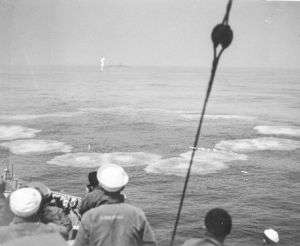Battle of Point Judith
| Battle of Point Judith | |||||||
|---|---|---|---|---|---|---|---|
| Part of World War II | |||||||
 Sailors aboard USS Moberly firing on U-853. | |||||||
| |||||||
| Belligerents | |||||||
|
|
| ||||||
| Strength | |||||||
|
Sea 1 destroyer 2 destroyer escorts 1 frigate 1 collier Air: 2 blimps | 1 U-boat | ||||||
| Casualties and losses | |||||||
|
12 killed 1 collier sunk |
55 killed U-853 U-boat | ||||||
The Battle of Point Judith is the popular name for a naval engagement fought between the United States and Nazi Germany during World War II on May 5 and 6, 1945. American surface combatants and two blimps sank a German U-boat off Point Judith, Rhode Island in one of the last actions of the Battle of the Atlantic.
Battle
U-853 was one of five U-boats dispatched in February 1945 for operations off the North American coast. By May 1945, she was one of just six operating off the North American coast, and the only one of the February boats remaining active. She was operating off the coast of Rhode Island in May 1945, after one success.
On 5 May, U-853 was lying in wait off the point when she sighted and fired on the SS Black Point, a collier with armed guards aboard underway for Boston, Massachusetts. Her torpedoes struck and Black Point capsized within fifteen minutes in 95 ft (29 m) of water, the last American-flagged merchant ship sunk in the war. Twelve men died, including one of the guards, and thirty-four others were rescued by nearby vessels. One of the rescuing ships, the SS Kamen, sent a report of the torpedoing that was picked up by Eastern Sea Frontier HQ in New York and by 1st Naval District HQ in Boston, who immediately started to assemble a search and destroy mission. This marks the last ship sunk in U.S. waters by a German U-boat.[1]
The nearest warships were the vessels of Task Force 60.7, under the command of Commander F. C. McCune. TF60.7 was en route to Boston, having escorted convoy GUS 84 to New York City. TF60.7 comprised the destroyer USS Ericsson (Lt.Cdr CA Baldwin), destroyer escorts USS Amick (Lt.Cdr EL Barsumian) and Atherton (Lt.Cdr L Iselin ), and frigate USS Moberly (Lt.Cdr Tollaksen CG, ). Ericsson was transiting the Cape Cod Canal with McCune on board when the summons came, so the remaining four ships headed for Kamen’s location, with Tollaksen in temporary command.[2]
The ships arrived at 19.30 and commenced their search and, just before midnight, they discovered U-853 bottomed in 108 ft (33 m) of water. They made an attack, and oil was sighted just after midnight, sparking the first series of claims that the U-boat had been destroyed. The ships continued to find contacts, however, and the attacks on them also continued. Ericsson arrived during the night, and McCune resumed command. Amick was detached to make a pre-arranged rendezvous, and reinforcements arrived later, comprising the destroyers Barney, Breckinridge, and Blakeley, the frigate Newport, the corvettes Action and Restless, and the auxiliary destroyer Semmes. These took up position around the search site to guard against the U-boat slipping past the attackers.
The attacks continued through the night, and oil, planking, life rafts, a chart tabletop, clothing, and an officer's cap were detected at 0530. Nevertheless, destruction of U-853 was not accepted by HQ in Boston, and the hunt continued. After daybreak, K class blimps K-16 and K-58 from Lakehurst, New Jersey joined the attack, locating oil slicks and marking suspected locations with smoke and dye markers. K-16 also attacked with 7.2 in (180 mm) rocket bombs. Finally, Eastern Sea Frontier HQ accepted the destruction of the U-boat, and the hunt was called off at 1207.
Conclusion
Later that day, divers from USS Penguin found the wreck of U-853 in 130 feet of water. There was evidence of two hits which had resulted in its destruction, along with all fifty-five men.
It is clear that U-853 was destroyed at some point between midnight and mid-day on the 6th and that many of the attacks made by TF60.7 were tin-opener attacks—i.e., made on a U-boat wreck in order to gain evidence of destruction. During the 17-hour hunt, TF60.7 expended 264 Hedgehog bombs, 95 depth charges, and 6 rocket bombs; at least one ship was damaged by the concussion from the ordnance exploding in shallow waters.
External links
References
- Notes
- ↑ Lynch, Adam. "Kill and Be Killed? The U-853 Mystery". U.S. Naval Institute. Retrieved 29 March 2015.
- ↑ DiCarpio, Ralph. "The Battle of Point Judith". Destroyer Escort Sailors Association. Retrieved 29 March 2015.
- Bibliography
- Clay Blair: Hitler's U-Boat War Vol II (1998). New York: Random House. ISBN 978-0-679-45742-8
- Paul Kemp: U-Boats Destroyed (1997). ISBN 1-85409-515-3
- Axel Neistle: German U-Boat Losses during World War II (1998). ISBN 1-85367-352-8
- Battle of Point Judith : Ralph DiCarpio 2003